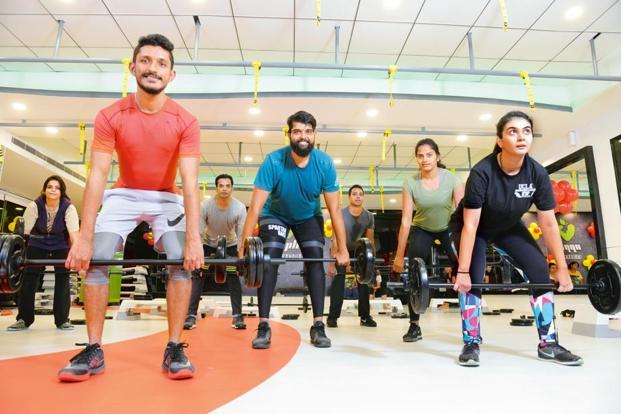Set to a pulsing rhythm of 10 tracks, BodyPump is a workout routine that uses High-Intensity Interval Training (Hiit). In 2012, Sanjay Reddy was 23 years old and weighed 168kg. “Even for my 6ft, 3 inches height, that was obese,” he says. Bored of a gym routine, he joined Cult Tribe, a fitness centre in Bengaluru. That’s when he was introduced to BodyPump, an exercise routine put together by New Zealand-based fitness company Les Mills International.
“It was a group workout of 15-20 people with weights, set to the latest DJ songs, with constant motivation by the instructor. The music, the healthy competition within the class and the energetic movement with weights completely pumped me up, leaving me with an exciting, happy feeling,” he says.
BodyPump makes you shed weight fast
Three years later, he had shed the flab and was happy about the way the workout had changed him physically and mentally. In 2015, he participated in a Les Mills workshop in Hyderabad and became a freelance instructor for BodyPump.
Set to a pulsing rhythm of 10 tracks, BodyPump is a workout routine that uses High-Intensity Interval Training (Hiit). It is specifically designed to help build lean muscle and strength, and improve your fat-burning ability, Reddy says. It’s also the ideal workout for anyone who wants to strengthen their muscles without gaining that bulky bodybuilder look.
Several gyms across India today have been certified by Les Mills and are conducting BodyPump classes. Explaining how it works, Amandeep Kaur Ahuja, training coordinator, Les Mills Dubai, says: “It is total body-resistance training using light to moderate barbells and high repetitions, with quick transitions and less recovery between repetitions and sets.” The 60-minute routine, set to a soundtrack of 10 DJ favourites from around the world, is updated every quarter to ensure they are the trendiest. Each track focuses on a different muscle group. The first track is for warm-up, followed by music for squats, chest, back, triceps, biceps, shoulders and core exercises. The last track is for the cool-down, says Reddy.
What is bodyPump?
Overall, each track consists of specific exercises, including squats, chest presses, dead rows, clean and press, press pullover combos, lunges and reverse curls, to name a few. On each track, participants do 70-100 repetitions of a particular exercise. “On the whole, you do approximately 800 repetitions of about 10 exercises with three-four variations each, all with the barbells in hand,” says Kamal Chhikara, master trainer, Reebok India, and owner, Reebok CrossFit Robust gym, Delhi.

In the process, you work out your legs, chest, back, gluteal region, hamstrings, triceps, biceps, shoulders, arms and abdominal muscles. The idea is to tire your muscles so that they do not add bulk, only strength and tone. The routine may sound painful, but remember, the weights you would be using are minimal.
“This high-intensity workout is designed to build pressure within each muscle group, create an after-burn that spikes the metabolism, and help you achieve a toned body quickly,” says Sandeep Dhar, consultant physiotherapist, Columbia Asia Hospital, Bengaluru. “It’s an ideal workout routine for those who are out of shape.”
Why bodyPump works
One of the biggest advantages of the BodyPump routine is that anyone can do it. Since the weights are light, and you’re working out in a group, pumping and stepping to music, it’s a great choice for someone who is exercising for the first time. The routine improves your aerobic fitness, helps you shed weight, gain muscle strength and endurance, and gives you a lean body, says Hardik Patel, physiotherapist, Hiranandani Hospital, Mumbai.
“Since it’s a group workout, it has the added benefit of being psychologically beneficial too,” he adds. For this group exercise sees the instructor on stage, demonstrating and explaining moves that people then copy. The fact that it’s set to music makes it more alluring.
For people like Reddy, who get bored sweating it out alone, the group dynamics work really well, motivating and inducing a sense of competition. “You make friends, indulge in some healthy competition and go back home with good vibes,” says Reddy. He says an instructor too needs to be more involved—for you’re not just directing, you’re also doing each and every exercise on stage with the group. “It’s exhausting but exhilarating,” he adds.
Then there’s the fact that while most workouts focus either on strength training or cardio, BodyPump does both, making it a great option for people who don’t have time to do these separately, says Mumbai-based fitness trainer Vinod Channa. “The workout combines barbells, dumbbells or your body weight and builds strength with cardio in a fast repetition and fast-set mode. It works on different body parts, keeping you breathless as well as improving your endurance and agility,” says Channa. Since it’s an Hiit workout, a BodyPump class two-three times a week is more than enough to get you results.
For BodyPump, exercise caution
Most facilities certified by Les Mills offer a range of levels for BodyPump workouts. Anyone who is healthy and injury-free—or, in the case of a pre-existing condition, has a go-ahead from his or her doctor—can do it, says Vesna Pericevic Jacob, founder, Vesna’s Alta Celo, a wellness clinic in Delhi. You should, however, avoid the workout if you have had cardiac or respiratory problems, says Patel, adding that it’s best to visit a cardiac rehab centre to get your cardiorespiratory fitness levels checked before you start the workout . “Individuals with musculoskeletal injuries or chronic pain and hypertensive patients should also avoid it,” he says.
Moreover, if you experience breathing problems, giddiness, headaches, tightness in the chest, or pain in the back or knees during a session, you should stop immediately. “Ask your instructor to review your workout regimen to avoid serious injury,” Patel says.
Jacob says there is a greater possibility of injury in a group class where you’re using weights with quick repetitions for over an hour. “It’s a high-risk environment and no matter how good the instructor is, he or she cannot keep an eye on every individual,” she explains. The moment you feel exhausted, she advises, put the bar down. Ahuja recommends choosing smaller weights, doing fewer repetitions and taking breaks, if you feel exhausted. Never add too much weight too early and push your fatigued body.
Read the complete article on livemint.com

